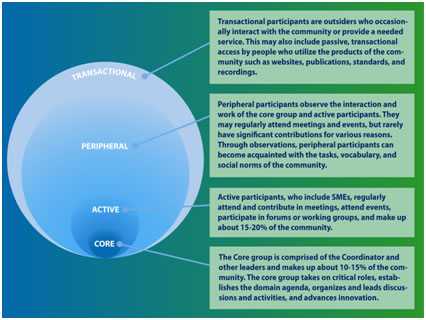Facilitate Participation
Sustain a CoP
Ideal community design takes into account varying levels of participation. Your community will have a core group of members, in addition to its leaders, who are actively engaged in most of the work of the community. You should also assume that many of your community members will be peripheral members and will not actively participate in much of the exchange that occurs. You might be prone to insist that everyone “actively” participate, but keep in mind that peripheral participants “are an essential dimension of communities of practice”.12 The figure below outlines the types of members you might see in your CoP.

Even though member participation may wax and wane, you allow everyone to be recognized as full members by ensuring your CoP protects the opportunity for various levels of engagement. Fluid boundaries can also create opportunities for individuals to fulfill the right roles at the right time.10
Just Remember....
Choosing the right tools makes all the difference. The methodology, technology, and tools you choose to host events and store your community’s knowledge should be appropriate for your membership. Whatever you choose, ensure that your membership is already familiar and comfortable with the medium or ready to learn. Members should not have to grapple with unfamiliar technology to participate effectively.
“When communities determine what they need to share and what forum will best enable them to share it, they can more readily own both the knowledge and forums for sharing it.”
— Richard McDermott
Co-Author
Cultivating Communities of Practice
Help Build Relationships
One of the most critical functions of CoP leadership is to enhance connections, reciprocity, and trustworthiness between community members. This task is often performed by the People Connector who works to obtain a deeper knowledge of members and develop sensitivity to group dynamics that can hasten or hinder community building.5 A People Connector should look for opportunities to link members to one another, make introductions and broker relationships.1
Distributed Communities
Members located in different geographic locations, organizations, and jurisdictions present a special challenge for CoP leaders. While convening a CoP with a diverse makeup has a great potential for producing notable outcomes,13,14 particular care should be taken when developing relationships between members. When community members cannot rely on regular face-to-face interaction, participation in the community takes additional, intentional member effort..1 In light of these challenges, the roles of Sponsor, Leader, Facilitator, and People Connector are all heightened.
Facilitators provide key support in ensuring that all member perspectives are represented in meetings and events hosted by the CoP. Facilitators manage and facilitate distributed groups of people by using a variety of tools and applying their skills in a different environment. Refer to the “Facilitating Distributed Groups” document to review specific responsibilities of facilitators in this environment and to get tips on things to do before, during, and after a synchronous or asynchronous event or interaction.
Sponsors facilitate relationship-building in a distributed community through supporting shared community norms, even if they are inconsistent with norms of the sponsoring sector, organization, or unit. For instance, if the sponsoring agency is one that traditionally promotes competition between divisions or units, the CoP sponsor can still promote collaboration as an expected community norm. CoP leaders then become increasingly responsible for supporting the community’s cultural norms. With representation from different geographical locations and different sectors, you can assume that members will not have shared norms and values for interaction or working.1 As participants from the private sector may be concerned with divulging proprietary information, participants from the government sector may not be accustomed to working with senior officials on a collegial level. Additionally, participants from different regional areas may have dissimilar methods of seeking and sharing information. When developing the CoP charter, it is important to clearly state the CoP’s expectations for sharing knowledge and achieving goals. It is equally important to convey these community values consistently through socialization efforts for new members (see “Mentor/Protégé Agreement”), and you may want to make these expectations known in public forums where members interact. Clearly establishing and stating the CoP’s norms and expectations at the outset may add a sense of stability, trust, and reciprocity to the community—particularly when these norms are maintained by leaders and community members through role-modeling and correction, where needed. 21
|
Related Resource |
Description |
Audience |
|---|---|---|
|
The Facilitator may want to explore the specific responsibilities of facilitators in this environment and to get tips on things to do before, during, and after an event or meeting. |
Facilitators and other Leaders of Communities of Practice (CoPs) |
|
|
If you set up a Mentor-Protégé program, it may be helpful to give participants some guidelines for coming up with an agreement. This resource may also be used by community members who want to enter into a mentor/protégé relationship on their own. This customizable template can be used to ensure that participants are considering concrete action items when making their arrangement. |
Members of Communities of Practice (CoPs) who are interested in forming a Mentor/Protégé relationship as either Mentor or Protégé |
- Page last reviewed: March 2, 2015
- Page last updated: May 6, 2011
- Content source:


 ShareCompartir
ShareCompartir



